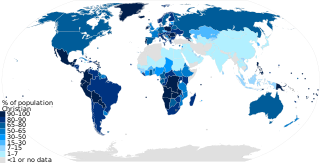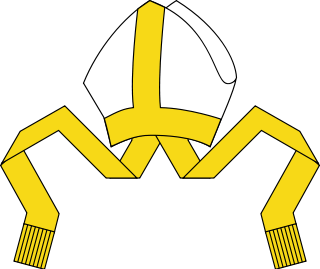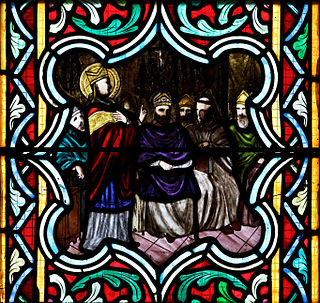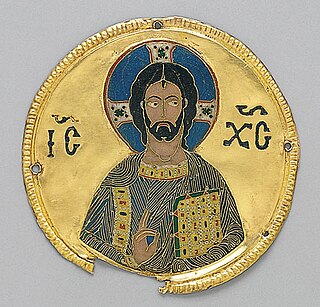
Ambrose of Milan, venerated as Saint Ambrose, was a theologian and statesman who served as Bishop of Milan from 374 to 397. He expressed himself prominently as a public figure, fiercely promoting Roman Christianity against Arianism and paganism. He left a substantial collection of writings, of which the best known include the ethical commentary De officiis ministrorum (377–391), and the exegetical Exameron (386–390). His preachings, his actions and his literary works, in addition to his innovative musical hymnography, made him one of the most influential ecclesiastical figures of the 4th century.

Christendom historically refers to the Christian states, Christian empires, Christian-majority countries and the countries in which Christianity dominates, prevails, or that it is culturally or historically intertwined with.

In the history of Europe, the Middle Ages or medieval period lasted approximately from the late 5th to the late 15th centuries, aligning with the post-classical period of global history. It began with the fall of the Western Roman Empire in 476 AD and ended with the fall of Constantinople in 1453 AD before transitioning into the Renaissance and then the Age of Discovery. The Middle Ages is the middle period of the three traditional divisions of Western history: antiquity, medieval, and modern. The medieval period is itself subdivided into the Early, High, and Late Middle Ages. Late medieval scholars at first called these the Dark Ages in contrast to classical antiquity; the accuracy of the term has subsequently been challenged.
Pope Hormisdas was the bishop of Rome from 20 July 514 to his death. His papacy was dominated by the Acacian schism, started in 484 by Acacius of Constantinople's efforts to placate the Monophysites. His efforts to resolve this schism were successful, and on 28 March 519, the reunion between Constantinople and Rome was ratified in the cathedral of Constantinople before a large crowd.
The Synod of Whitby was a Christian administrative gathering held in Northumbria in 664, wherein King Oswiu ruled that his kingdom would calculate Easter and observe the monastic tonsure according to the customs of Rome rather than the customs practiced by Irish monks at Iona and its satellite institutions. The synod was summoned at Hilda's double monastery of Streonshalh (Streanæshalch), later called Whitby Abbey.
Wilfrid was an English bishop and saint. Born a Northumbrian noble, he entered religious life as a teenager and studied at Lindisfarne, at Canterbury, in Francia, and at Rome; he returned to Northumbria in about 660, and became the abbot of a newly founded monastery at Ripon. In 664 Wilfrid acted as spokesman for the Roman position at the Synod of Whitby, and became famous for his speech advocating that the Roman method for calculating the date of Easter should be adopted. His success prompted the king's son, Alhfrith, to appoint him Bishop of Northumbria. Wilfrid chose to be consecrated in Gaul because of the lack of what he considered to be validly consecrated bishops in England at that time. During Wilfrid's absence Alhfrith seems to have led an unsuccessful revolt against his father, Oswiu, leaving a question mark over Wilfrid's appointment as bishop. Before Wilfrid's return Oswiu had appointed Ceadda in his place, resulting in Wilfrid's retirement to Ripon for a few years following his arrival back in Northumbria.
Hydatius, also spelled Idacius was a late Western Roman writer and clergyman. The bishop of Aquae Flaviae in the Roman province of Gallaecia, he was the author of a chronicle of his own times that provides us with our best evidence for the history of Hispania in the 5th century.
The East–West Schism, also known as the Great Schism or Schism of 1054, is the ongoing break of communion between the Roman Catholic and Eastern Orthodox churches since 1054. It is estimated that, immediately following the beginning of the schism, a slim majority of Christians worldwide were Eastern Christians; most of the rest were Western Christians. A series of ecclesiastical differences and theological disputes between the Greek East and Latin West preceded the formal split that occurred in 1054. Prominent among these were the procession of the Holy Spirit (Filioque), whether leavened or unleavened bread should be used in the Eucharist, the Pope's claim to universal jurisdiction, and the place of the See of Constantinople in relation to the pentarchy.

Constantinian shift is used by some theologians and historians of antiquity to describe the political and theological changes that took place during the 4th-century under the leadership of Emperor Constantine the Great. Rodney Clapp claims that the shift or change started in the year 200. The term was popularized by the Mennonite theologian John H. Yoder. He claims that the change was not just freedom from persecution but an alliance between the State and the Church that led to a kind of Caesaropapism. The claim that there ever was a Constantinian shift has been disputed; Peter Leithart argues that there was a "brief, ambiguous 'Constantinian moment' in the fourth century", but that there was "no permanent, epochal 'Constantinian shift'".

Warren H. Carroll was the founder and first president of Christendom College in Front Royal, Virginia. He authored multiple works of Roman Catholic church history.

During the reign of the Roman Emperor Constantine the Great, Christianity began to transition to the dominant religion of the Roman Empire. Historians remain uncertain about Constantine's reasons for favoring Christianity, and theologians and historians have often argued about which form of early Christianity he subscribed to. There is no consensus among scholars as to whether he adopted his mother Helena's Christianity in his youth, or, as claimed by Eusebius of Caesarea, encouraged her to convert to the faith he had adopted.

Alexander I of Alexandria was the 19th Pope and Patriarch of Alexandria. During his patriarchate, he dealt with a number of issues facing the Church in that day. These included the dating of Easter, the actions of Meletius of Lycopolis, and the issue of greatest substance, Arianism. He was the leader of the opposition to Arianism at the First Council of Nicaea. He also mentored his successor, Athanasius of Alexandria, who would become one of the Church Fathers.
A chorbishop is a rank of Christian clergy below bishop. The name chorepiscope or chorepiscopus is taken from the Greek χωρεπίσκοπος and means "rural bishop".

Thomas John Curry is an Irish-born American prelate of the Roman Catholic Church. Curry served as an auxiliary bishop of the Archdiocese of Los Angeles from 1994 to 2018. From 1994 to 2013, he was the episcopal vicar of the Santa Barbara Pastoral Region.
John of Tella (483–538) was a monk and bishop in the Near East. John was a major proponent of moderate Miaphysitism. Although his native language was Syriac he studied Greek in order to serve in the Byzantine administration. John was a native of Callinicus. He was influenced to become a monk by reading the Acts of Thecla. He later studied at the monastery founded by Gregory Nazianzen.
The papal deposing power was the most powerful tool of the political authority claimed by and on behalf of the Roman Pontiff, in medieval and early modern thought, amounting to the assertion of the Pope's power to declare a Christian monarch heretical and powerless to rule.

The Council of Bari was convened and presided over by Pope Urban II in Bari, Italy, in October 1098 during the First Crusade. It was attended by 185 bishops, both Catholic and Orthodox.

Christianity in the 11th century is marked primarily by the Great Schism of the Church, which formally divided the State church of the Roman Empire into Eastern (Greek) and Western (Latin) branches.

Christianity in the Middle Ages covers the history of Christianity from the fall of the Western Roman Empire. The end of the period is variously defined. Depending on the context, events such as the conquest of Constantinople by the Ottoman Empire in 1453, Christopher Columbus's first voyage to the Americas in 1492, or the Protestant Reformation in 1517 are sometimes used.
Christianity became the official religion of the Roman Empire when Emperor Theodosius I issued the Edict of Thessalonica in 380, which recognized the catholic orthodoxy of Nicene Christians in the Great Church as the Roman Empire's state religion. Most historians refer to the Nicene church associated with emperors in a variety of ways: as the catholic church, the orthodox church, the imperial church, the imperial Roman church, or the Byzantine church, although some of those terms are also used for wider communions extending outside the Roman Empire. The Eastern Orthodox Church, Oriental Orthodoxy, and the Catholic Church all claim to stand in continuity from the Nicene church to which Theodosius granted recognition.











